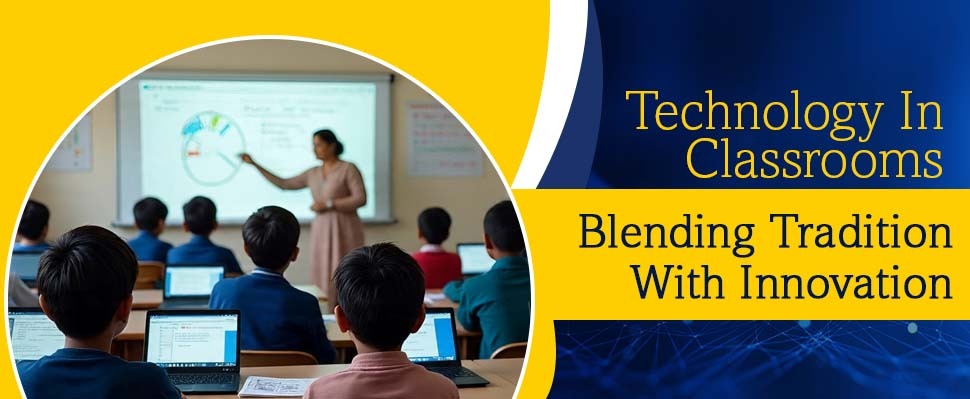Affiliated to CISCE New Delhi (Home Centre for ICSE & ISC)
Affiliated to CISCE New Delhi (Home Centre for ICSE & ISC)

July 17, 2025
HSMS
There has been enough debate on whether traditional classroom learning or advanced digital learning tools are better suited for creating an effective learning experience for students. But with the emerging blended learning technology, this debate is no longer relevant.
Blended learning is the seamless integration of advanced technology with traditional classroom learning experience to provide the best of both worlds to every student. Tools like smart boards and smart class software have completely revolutionized education in the modern world while still retaining the age-old essence of classroom learning.
Why is introducing technology in the traditional classroom learning structure the need of the hour?
From AI-powered online courses to educational apps built on VR, technology has opened up new horizons in the education sector. Here are a few reasons why both students and teachers love the concept of blended learning:
1. Better engagement levels
Multimedia presentations, Live quizzes, and interactive discussions that enable a collaborative learning experience help students to understand the learning material much better than plain textbook readings. Blended learning creates a hyper-interactive experience and allows students to learn even beyond the physical classroom.
2. Personalized learning experience
When it comes to blended learning, every student can follow their own customized learning path that adapts to their own unique needs and pace. In a blended learning setup, no student needs to rush through the learning material and can take their own time to understand different concepts, which supports long-term retention.
3. Access to a global learning community
By introducing digital tools in a traditional classroom setup, students can learn from the best tutors across the world. They can have collaborative discussions with fellow students from any part of the globe, participate in international competitions, conferences, workshops and seminars and even get access to global experts through virtual meetings. All of this takes the learning experience to the next level altogether.
4. Real-world application
One of the best features of blended learning is that the gap between theoretical learning and practical real-world application is bridged with virtual labs, augmented reality, simulations and other advanced technologies. Students get hands-on training on how they can apply their knowledge outside the classroom, which opens up significantly better job opportunities for them.
5. Efficient resource utilization
Investing in smart classroom equipment is a one-time expense that saves costs in the long run as compared to constantly re-stocking physical learning material. Blended learning reduces damage to the environment, which is extremely crucial now more than ever.
Why is it still important to retain the traditional classroom aspect of learning instead of going completely digital?
The hybrid model of blended learning leverages the best use of technology in education without creating social isolation among students. Students still get to interact with their peers and teachers in a shared space, which helps in the development of their social skills and supports their mental well-being. The presence of a physical teacher in a classroom also keeps the students better disciplined and more accountable, instead of getting swayed by technology.
In today’s world, where technology has integrated into every aspect of our lives, the importance of blended learning is no longer a question. The future of global education lies in a blended learning model as a step towards upgrading the learning experience.